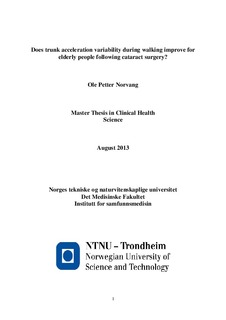Does trunk acceleration variability during walking improve for elderly people following cataract surgery?
Master thesis
Permanent lenke
http://hdl.handle.net/11250/281661Utgivelsesdato
2013Metadata
Vis full innførselSamlinger
Sammendrag
Background; Increased trunk acceleration variability during gait may be considered as a sign
of impaired dynamic postural stability. Vision is an important factor in maintaining postural
stability during walking, and impaired vision has been shown to influence trunk acceleration
variability.
Purpose; The aim of this study was to examine the long-term effects of cataract surgery on
trunk acceleration variability during walking, in comparison to a vision-healthy control group.
Material and method; Trunk acceleration variability was investigated before and 12 months
after cataract surgery, to detect changes over time and compare these between the groups. One
hundred and four older adults (mean age 78.4 years, SD 4.9) undergoing cataract surgery and
fifty-three vision-healthy, older controls (mean age 80.8 years, SD 3.8) were included in this
study. Participants performed timed walking at preferred and fast gait speeds, and in two
lighting conditions; normal and subdued, and trunk accelerations in three dimensions were
measured during walking using a triaxial accelerometer. Trunk acceleration variability was
calculated by using an unbiased autocorrelation procedure.
Results; In normal light at preferred gait speed there were significant differences in the
changes between the cataract and the control group in all directions; AP (p=0.01), V (p<0.01),
and ML (p<0.01). In fast gait speed no significant differences in the changes between the two
groups were detected. In subdued light a similar pattern was found with significant
differences in the changes between the two groups in preferred gait speed; (AP (p=0.01), V
(p<0.00), and ML (p<0.00); but only a significant difference in the change in the vertical
direction during fast gait speed.
Conclusion; The findings of this study suggest that patients improve their postural stability
during walking during the year following cataract surgery.
Relevance
Postural stability amongst the elderly population is a complex challenge, and a topic that is
highly relevant to persons working with rehabilitation or to prevent a drop in daily
functioning for elderly. Knowledge to understand the relative role of vision correction in
maintenance of postural stability (balance during walking) is important, because of the
complex inter-relations between vision and trunk motion during gait, which is important for
daily functioning and falls risk. With an increasing elderly population in Norway, knowledge
of this will be important to prevent accidents, but also in order to prevent increasing costs
following a fall and thereby an increased need for help in daily life.
